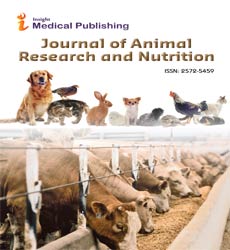Abstract
Agronomic Performance, Yield, and Compatibility of Intercropped Sudan Grass (Sorghum sudanense) and Vetch (Vicia dasycarpa) with Different Seed Ratio
The objective of this study was to evaluate the agronomic performance and nutritive value of Sudan grass (Aden-gode) and vetch (Vicia dasycarpa) intercropping in different seed rate proportion. The experiment was laid with Randomized Completed Block Design (RCBD) with five (5) seed rate proportion treatments (100%, 75%:25%, 50%:50%, 25%: 75%, and 100%) intercropped with three replications. Irrigation, weeding, and hoeing were used as a managemental practice. All data of both grown forages were recorded from four middle rows (4th, 5th, 6th, and 7th) of ten (10) plants with a total of 3.6 m2 area to determine forage yield. Subsamples were weighted, dried, and then grounded for chemical composition analyses. All recorded data were subjected to the GLM procedure of SAS (9.0). The results showed that most of agronomic, dry matter yield, and chemical compositions of both grown forages were significantly (P<0.05) affected, while stem thickness, root length, and ADF% of Sudan grass (Aden-gode) and root length and ADL% of vetch (Vicia dasycarpa) were not significantly (P>0.05) affected. The highest total DMY and CPY (13.21 t/ha and 2.08 t/ha) and the lowest total DMY and CPY (5.04 t/ha and 0.47 t/ha) were found from 75%: 25% seed rate treatment, respectively. LER in present study was greater than one (>1) in all treatments and Sudan grass had less competitive and aggressively in 75%:25% seed rate treatment. Therefore, production of 75%:25% seed rate intercropping of Sudan grass (Aden-gode) with vetch (Vicia dasycarpa) would be more beneficial to produce optimum forage yield and better nutritive value.
Author(s): Tenaw Temesgen* and Yeshambel Mekuriaw
Abstract | Full-Text | PDF
Share this

Google scholar citation report
Citations : 764
Journal of Animal Research and Nutrition received 764 citations as per google scholar report
Abstracted/Indexed in
- Google Scholar
- China National Knowledge Infrastructure (CNKI)
- WorldCat
- International Committee of Medical Journal Editors (ICMJE)
- Secret Search Engine Labs
Open Access Journals
- Aquaculture & Veterinary Science
- Chemistry & Chemical Sciences
- Clinical Sciences
- Engineering
- General Science
- Genetics & Molecular Biology
- Health Care & Nursing
- Immunology & Microbiology
- Materials Science
- Mathematics & Physics
- Medical Sciences
- Neurology & Psychiatry
- Oncology & Cancer Science
- Pharmaceutical Sciences

